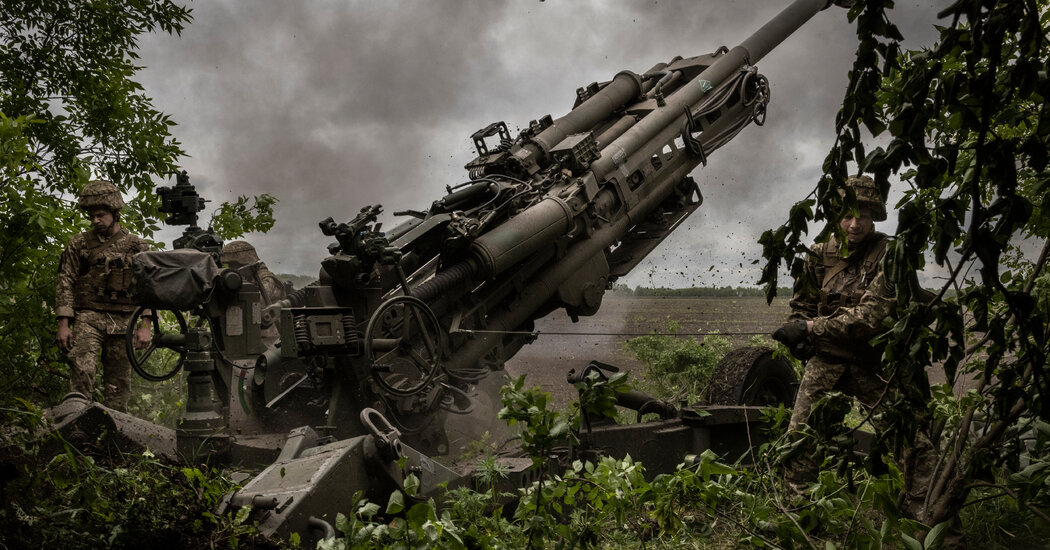
Amid the roar of artillery and bone-rattling explosions, New York Times photographers have borne graphic witness to the fight to survive. These are their stories and images.
Lynsey Addario, Finbarr O’Reilly and
Through the three months of Russia’s invasion, New York Times journalists have chronicled carnage and courage, ruin and resolve, across the wide arc of combat through eastern Ukraine, where Vladimir V. Putin’s brutal offensive is now concentrated.
At the front line and within easy range of it, they have joined civilians whose homes, families and emotions have been shattered, as well as Ukrainian soldiers — hardened veterans and green volunteers — using tools as modern as surveillance drones and as ancient as trenches.
Amid the roar of artillery, the clatter of small arms and bone-rattling explosions, Times photographers have borne graphic witness to the fight to survive and kill — or just survive. These are their accounts and images from the last few weeks of that fight.
On the front line south of Izium, a Russian-captured city just north of the Donetsk region, two Ukrainian 122-mm guns thundered across the rolling landscape last week. They belonged to an artillery detachment of the 93rd Mechanized Brigade, called in to fire on Russian forces who had pinned down Ukrainian troops.
The camouflaged gunners then worked at lightning speed to conceal their position, moving broken branches to hide from view the smoking barrels of the powerful weapons. A young soldier wearing a bandanna and a determined expression burst out of the greenery, sprinting back into the woods to hide from enemy drones. Soon the team was reloading, aiming and firing again.
Along the same front, a dozen members of the 95th Air Assault Brigade camped in a concrete building at an abandoned farmhouse. Throughout the night, in pairs, they took turns on sentry duty from inside a trench system worming down a hillside, overlooking a valley of rolling wheat fields pockmarked with dark clumps of dirt kicked up by the impact of recent shelling by Russian artillery.
Several nearby buildings had been shattered by shelling, and the thump of artillery exchanges between Ukrainian and Russian troops a few miles north rumbled day and night.
Artem Sandul, 20, pulled on a cigarette under the cover of a wood and mud bunker in the trenches as dawn broke. Until Russia invaded on Feb. 24, he had been flipping burgers at a McDonald’s. Now he was cooking for his fellow soldiers, his commander seemingly keeping him back from the most dangerous shelling a couple of miles up the road, where Ukrainian lines were only 400 yards from Russian lines in some places.
Near Izium, jets, most likely Russian, flew low over Ukrainian positions, firing defensive flares to confuse antiaircraft batteries, then made a sharp turn toward the trenches and screamed by so low that they disappeared behind a tree line before vanishing over the horizon.
On Tuesday, in Vuhledar, about 30 miles southeast of the Russian-occupied Donetsk, an artillery team from the 53rd Brigade responded to Russian artillery fire the soldiers said was coming from inside a church about four miles away.
In Barvinkove, a Ukrainian-held town 20 miles southwest of Izium, a cyclist pedaled past blown-out buildings and a barricade, while at a small base, soldiers drank coffee and a sniper prepared his rifle for a mission. Nearby, Russian forces were trying to push southward, part of a pincer move to trap the Ukrainian troops still holding a pocket of territory in the two eastern provinces of Donetsk and Luhansk.
On the seesawing front line of that pocket lies Bakhmut, a largely evacuated town of blasted building shells, rubble and incinerated vehicles, where two huge craters bracket the administrative building. In newly reinforced defensive positions, Ukrainian soldiers tried to hold off the Russian advance, amid the constant din and ground shudder of artillery fired by both sides.
In that region, Times photographers encountered evidence of Russian losses, too. Ukraine’s Territorial Defense Forces, mostly volunteer fighters, managed to retake the village of Novopil. With Russian troops still less than half a mile away, the evidence of a fierce battle was everywhere, in the wreckage of houses and the stench of dead bodies.
In front of a small shed, the body of a Russian soldier lay where he had been cut down, his clean, well-polished boots at odds with the surrounding devastation. His brown suede belt bore the hammer and sickle of the Soviet Union.
Near Bilohorivka were the ravaged bodies and tanks of hundreds of Russian troops whose disastrous attempt to cross the Seversky Donets River fell to deadly Ukrainian heavy artillery.
But many of those caught in the destruction did not wear uniforms. Vitaliy Kononenko, 47, had just built a new home for his family in the Zaporizhzhia region in southern Ukraine, but before he could bring his wife and children to see it, it was destroyed.
In the train station in Pokrovsk, in the Donetsk region, Anna Vereschak, 43, boarded a westbound evacuation train with her daughters Milana, 5, and Diana, 4, after bombardment forced them from their village. Another woman, Valentina, ushered her blind 87-year-old mother, Nina, onto the train.
Millions of Ukrainians have fled their homes, particularly from the east, taking only what they can cram into a bag or two, often after holding out for weeks or months in basements despite bombardment, hunger and isolation. Some of the fiercest fighting now is around Sievierodonetsk, in the Luhansk region, the easternmost city still held by Ukraine.
In Lysychansk, just across the bombed-out bridge from Sievierodonetsk, three police officers braved artillery fire to collect the bodies of the dead, like a 65-year-old woman known to neighbors as Grandma Masha. Her dog growled and barked from his kennel as they loaded her into a body bag and then their white van.
Grandma Masha could not get the medicine she needed to treat her diabetes, according to a neighbor, Lena, 39. Her son had left with his family and was not able to return when she fell ill.
“It’s a completely stupid war — but no one asked for my opinion,” said Lena, who, like most people interviewed, gave only her first name because she feared for her safety.
In an apartment block in Sievierodonetsk, already partially blasted and burned by shelling, residents huddled in the basement, resigned, at last, to evacuation. They barely reacted to the sounds of explosion and nearby gunfire.
Across the eastern Donetsk and Luhansk provinces, and the southern part of the Kharkiv region, Times photographers found Ukrainian troops in every imaginable phase of daily life in a combat zone.
In an underground bunker were dozens of members of the Carpathian Sich Battalion — eating, sleeping, cleaning their weapons and chatting on cellphones with their wives and girlfriends. Some gathered around a monitor to watch drone video of a recent attack. Most smoked.
Russia-Ukraine War: Key Developments
Military aid. The United States said it will send Ukraine advanced rockets as part of a new $700 million aid package, while Germany promised a modern air-defense system. The buttressing of Ukraine’s weaponry underscores Western resolve to hobble Russia’s war effort at a critical time.
The floor and walls of the bunker quaked as a tank round hit a nearby building, and small-arms fire followed. Bullets ricocheted off walls outside. The Russians were close.
A handful of Ukrainian soldiers dashed outside to repel the attack, while others collected their weapons and waited by the door in case they were needed. They weren’t; the shooting subsided.
One soldier lit a stove and began frying buckwheat.
At a well-guarded and heavily fortified checkpoint, fighters built more trenches and bunkers, using sandbags and rough-hewn logs, in preparation for a possible Russian advance in their direction. Warned of incoming artillery fire, they ducked into a bunker, and a medic in the group boasted that their hideouts could take almost anything the Russians might fire at them.
The evidence of war was strewn across the ravaged landscape. Wreckage was everywhere, from collapsed buildings and buckled streets to burned-out tanks. A common sight was the tail of a rocket sticking out of the ground, a reminder of the constant danger from above.
The smells and sounds of war were everywhere, too. Few civilians were around, but troops were omnipresent, patrolling, scavenging, resting and building fortifications when they were not fighting.
After their armored vehicle broke down, a dozen soldiers from Ukraine’s 95th Air Assault Brigade recently stood by a roadside near the city of Kramatorsk, smoking, like stranded commuters waiting for a lift.
An attempt to tow them failed, so the soldiers, with their weapons, piled aboard another armored vehicle and set off in the day’s fading light toward the front.
The men of the 93rd Brigade are at the forefront of efforts to hold off the Russian advance south of Izium. Small units of mortar teams have camped out in destroyed villages, battling Russian forces that have thrown everything at them.
They spoke of enduring days of near-constant shelling, sheltering in dank basements, surrounded by jars of pickled vegetables.
Thoughts rarely strayed far from the lethal stakes, but between such harrowing episodes, it was striking how the ordinary business of life, like a highway breakdown, never quite disappeared.
A kiosk in Bakhmut did a brisk trade serving coffee, burgers and sandwiches to soldiers coming and going from the fighting.
In Barvinkove, which has come under heavy Russian bombardment, a few local women were still hawking vegetables and dairy products under the shade of a tree in the town center. A passing soldier, back from the front to refuel, asked to buy some herbs.
The woman refused to take payment for her goods, waving him off and wishing him well.




